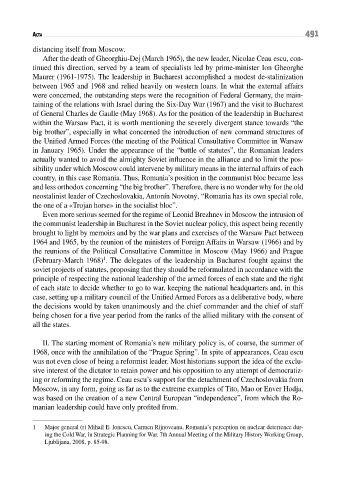Page 491 - Conflitti Militari e Popolazioni Civili - Tomo I
P. 491
491
aCta
distancing itself from Moscow.
After the death of Gheorghiu-Dej (March 1965), the new leader, Nicolae Ceaučescu, con-
tinued this direction, served by a team of specialists led by prime-minister Ion Gheorghe
Maurer (1961-1975). The leadership in Bucharest accomplished a modest de-stalinization
between 1965 and 1968 and relied heavily on western loans. In what the external affairs
were concerned, the outstanding steps were the recognition of Federal Germany, the main-
taining of the relations with Israel during the Six-Day War (1967) and the visit to Bucharest
of General Charles de Gaulle (May 1968). As for the position of the leadership in Bucharest
within the Warsaw Pact, it is worth mentioning the severely divergent stance towards “the
big brother”, especially in what concerned the introduction of new command structures of
the Unified Armed Forces (the meeting of the Political Consultative Committee in Warsaw
in January 1965). Under the appearance of the “battle of statutes”, the Romanian leaders
actually wanted to avoid the almighty Soviet influence in the alliance and to limit the pos-
sibility under which Moscow could intervene by military means in the internal affairs of each
country, in this case Romania. Thus, Romania’s position in the communist bloc became less
and less orthodox concerning “the big brother”. Therefore, there is no wonder why for the old
neostalinist leader of Czechoslovakia, Antonín Novotný, “Romania has its own special role,
the one of a «Trojan horse» in the socialist bloc”.
Even more serious seemed for the regime of Leonid Brezhnev in Moscow the intrusion of
the communist leadership in Bucharest in the Soviet nuclear policy, this aspect being recently
brought to light by memoirs and by the war plans and exercises of the Warsaw Pact between
1964 and 1965, by the reunion of the ministers of Foreign Affairs in Warsaw (1966) and by
the reunions of the Political Consultative Committee in Moscow (May 1966) and Prague
1
(February-March 1968) . The delegates of the leadership in Bucharest fought against the
soviet projects of statutes, proposing that they should be reformulated in accordance with the
principle of respecting the national leadership of the armed forces of each state and the right
of each state to decide whether to go to war, keeping the national headquarters and, in this
case, setting up a military council of the Unified Armed Forces as a deliberative body, where
the decisions would by taken unanimously and the chief commander and the chief of staff
being chosen for a five year period from the ranks of the allied military with the consent of
all the states.
II. The starting moment of Romania’s new military policy is, of course, the summer of
1968, once with the annihilation of the “Prague Spring”. In spite of appearances, Ceaučescu
was not even close of being a reformist leader. Most historians support the idea of the exclu-
sive interest of the dictator to retain power and his opposition to any attempt of democratiz-
ing or reforming the regime. Ceaučescu’s support for the detachment of Czechoslovakia from
Moscow, in any form, going as far as to the extreme examples of Tito, Mao or Enver Hodja,
was based on the creation of a new Central European “independence”, from which the Ro-
manian leadership could have only profited from.
1 Major general (r) Mihail E. Ionescu, Carmen Rijnoveanu, Romania’s perception on nuclear deterrence dur-
ing the Cold War, în Strategic Planning for War. 7th Annual Meeting of the Military History Working Group,
Ljublijana, 2008, p. 85-98.

